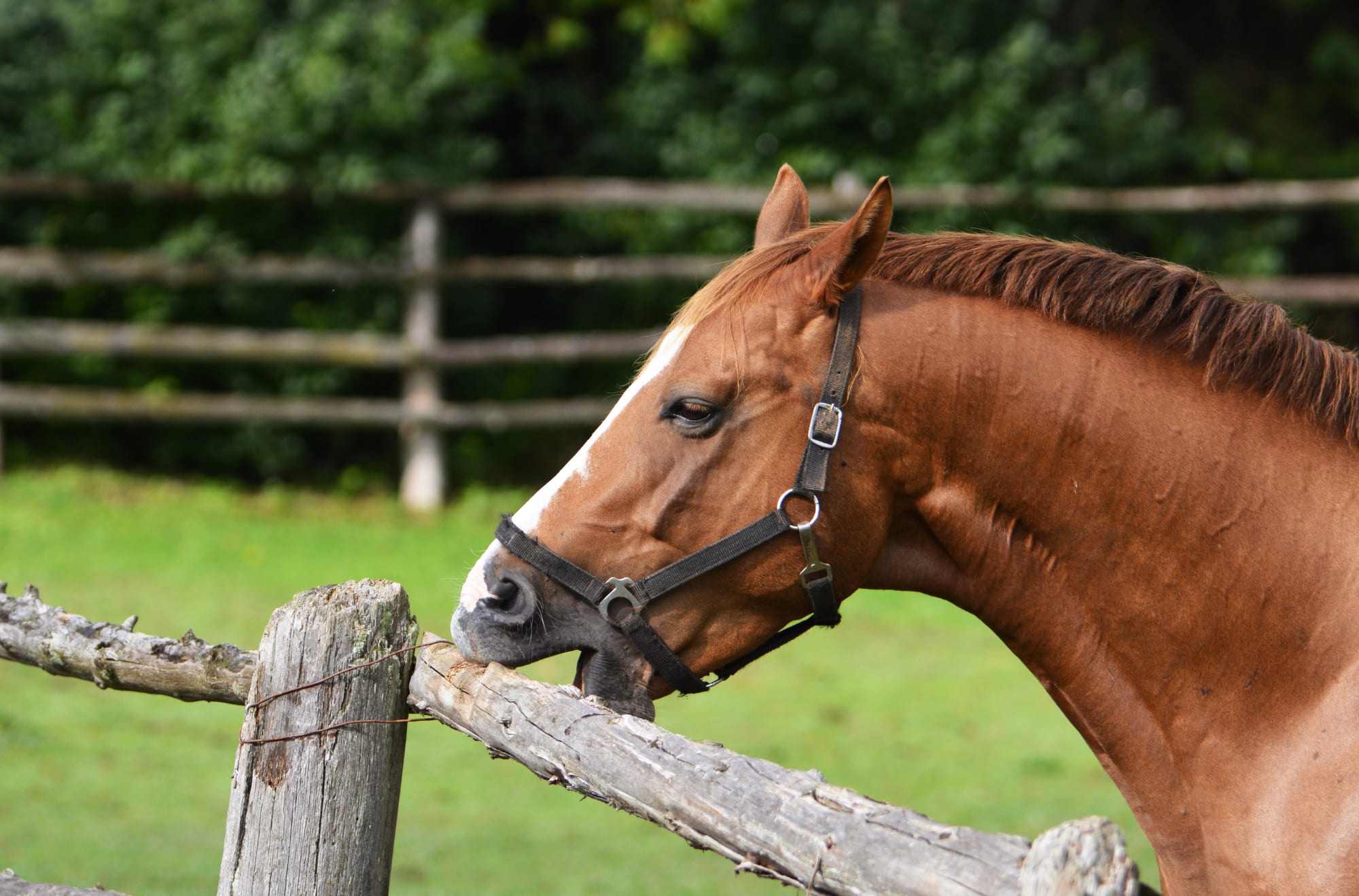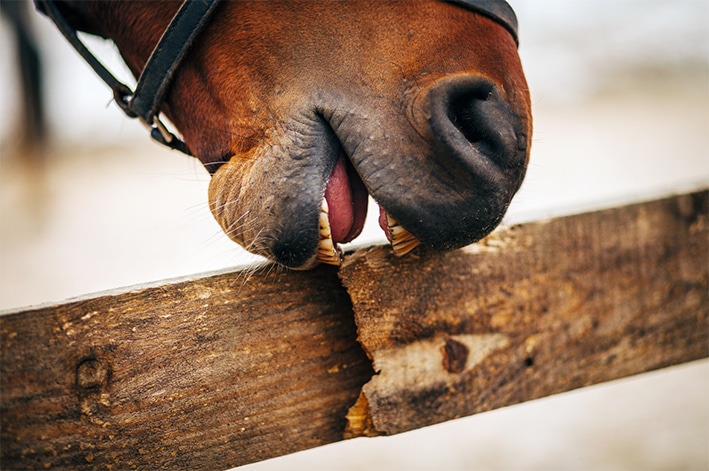
Those unwanted habits
Why do horses windsuck and crib? DR JENNIFER STEWART explains what’s going on and suggests some strategies to help with the problem.
There’s something special about the horse-human connection that makes horses strong contenders for the ‘man’s best friend’ title normally associated with dogs. Domesticated some 5,000 years ago, horses have held a place in our hearts ever since, but before domestication their lives were very different.
Wild horses roamed free in stable social groups, travelling up to 80km over their home range and taking more than 10,000 strides a day. In this natural environment, horses spent 16 to 20 hours a day grazing, and social relationships were reinforced by mutual grooming, food sharing, following behaviour, rest and play. Management of domesticated horses is very different: twice daily meals of high-energy concentrates and relatively little forage, plus housing conditions that limit social interactions.
Stereotypies (also called stall or stable vices) are ‘persistent repetitive behaviours that have no obvious goal or function’. Weaving, pawing, box walking, box circling, box kicking, tail-swishing and head tossing/nodding are examples of locomotor stereotypies. Oral stereotypies include tongue flicking, wriggling and rolling; teeth rubbing and grinding; lip licking and lip smacking; licking objects; sham chewing; self-biting; crib-biting, and, the most common, windsucking.

A horse who is crib-biting grasps a fixed object with their front teeth, arches their neck, pulls back and makes a grunting noise, seeming to ‘swallow’ air. When a horse doesn’t need to grasp an object to do this, it’s called windsucking. Horses may or may not draw air into the upper oesophagus, but x-rays show that the noise is a ‘burp’ and that air is rarely swallowed. Because of their similarities the two behaviours are often classed together.
Evidence suggests horses have been crib-biting and windsucking since their domestication. Between 15-37% of domestic horses develop oral stereotypies and over 8% engage in crib-biting/windsucking, which can occupy from 15 to 65% of their day. The behaviour, not seen in free-ranging horses, develops due to how we keep domesticated horses. It’s a problem we’ve created and therefore it really shouldn’t be referred to as a vice.
Proposed causes of cribbing range from boredom, lack of free exercise, lack of social connection, stress, digestive discomfort, and an equine version of obsessive-compulsive disorder, to the presence of ulcers, a genetic predisposition for chronic stress, a desire to nibble, and a meal fed diet.
Crucial in the development of wind-sucking and other oral stereotypies are feeding practices, housing/stabling conditions, weaning method, social contact, meal frequency and diets low in forage. Furthermore, certain breeds and disciplines are more susceptible to stereotypy: Thoroughbreds 3.1 times; Warmbloods are 1.8 times more likely to windsuck/crib; while 32.5% of dressage horses, 31% of eventers, and 19.5% of endurance horses practice the behaviours.
So, broadly speaking, stereotypic behaviours can develop when horses are deprived of carrying out patterns of behaviour that they are intrinsically motivated to perform, such as when they cannot avoid a stressful situation, cannot exercise or graze, or when they’re prevented from social contact.
Although crib biting/windsucking is found in horses spending a lot of time stabled, once established, they may exhibit these behaviours in other places. It can be quite disturbing to watch, especially for the first time. But why exactly do they do it? Is it harmful? Can it be treated? Can it be prevented?
Why they do it
The psychological need for foraging, roaming and social contact, combined with frustration, stress and modern diets, are the most likely causes in the development of stereotypies. Standard meal feeding and starch/sugary feeds cause a higher than normal release of stomach acid creating alimentary stress (stomach ulcers, hindgut acidosis), a source of discomfort and pain. Windsucking and cribbing increase saliva production and over 62% of affected horses exhibit the behaviour 2–8 hours after a meal. It’s thought this is an attempt to buffer the stomach and counteract gastric pain and acidosis. Antacids to modulate acid production reduce cribbing/windsucking in some horses. Increasing meal frequency can also reduce the behaviour, likely due to the increased time spent feeding and increased saliva production.
Stress and dopamine endorphins: Cribbing/wind-sucking are thought to be coping strategies as afflicted horses have increased sensitivity to touch and stress, and decreased behavioural flexibility. Windsucking apparently creates a pleasurable sensation, releasing brain endorphins (the body’s natural opiate). Injecting morphine-blocking drugs reduces windsucking in some horses, because, it’s thought, they no longer gain the pleasurable feeling from the activity and stop.
Alterations in brain dopamine levels are also found in windsuckers. Stressors such as social isolation are commonly associated with stereotypy development, which induce significant alterations to dopamine function. If the horse’s environment prevents them from attaining goals (movement, socialising, feeding), they stay in a heightened state of goal-attainment. Temporary elimination of crib-biting has been reported with naloxone, nalmefene or diprenorphine (used to treat alcohol and drug addictions in humans). These work in the brain to reduce the goal-attainment state, and when continuously infused for one week, no cribbing was observed. However, the behaviour returns when the drug is stopped.
Dopamine, a hormone that helps control pleasure and reward centres in the brain, is released during windsucking and affected horses have significantly more dopamine receptors in the part of the brain that controls goal-directed behaviours. Research into an area in the brain that deals with habit forming and the body’s reward centre, shows remarkable similarities to people with autism. This goes some way towards explaining why these horses find the action of cribbing/wind-sucking satisfying compared to a normal horse. Other studies have found reduced blood selenium levels – an important anti-oxidant.
Is it harmful?
Yes – windsucking/cribbing can be harmful. Health risks include:
- Damage to teeth
- overdeveloped neck muscles
- arthritis in the bones behind the throat
- reduced appetite and weight loss
- high incidence of ulcers: these may be the cause rather than the result – cribbers should be managed as an ulcer-prone, colic-prone horse
- double the risk of medical and surgical colics – not because the behaviour causes colic but because horses with colic are commonly fed less frequently, with less hay and more grain. This supports the theory that cribbing/windsucking is associated with gut discomfort and underlying gastrointestinal dysfunction.
Can it be treated?
There are behavioural, mechanical and surgical controls for cribbing. Placing a snug leather strap around the throatlatch area may control the behavior (care must be taken to avoid interference with airways). The strap allows the horse to eat but inhibits their ability to arch the neck and use their muscles to suck air.
More severe cribbing straps that include points and chains injure horses and rarely work; cribbing cages allow the horse to eat food but prevent them from grasping objects on which to crib. Cutting muscles and nerves in the throat/neck has a 70 to 80% success rate, but works best in younger horses who have been cribbing/windsucking for less than a year.
Horses with these behaviours are highly motivated to perform them, and will, unless the cause is treated, continue to perform them at higher levels after intervention. If they are crib-biting to relieve discomfort or improve their digestion, preventing them from doing so may be harmful. When the habit is firmly ingrained, it is virtually impossible to stop without either mechanical or surgical means.
A special note on weaning
Weaning is important in the potential future development of stereotypies because it is the initiation point. Over 65% of windsuckers/cribbers develop the habit within a month of weaning, and 10.5% of weanlings show the behaviour by 20 weeks of age. Foals fed on starch/sugar, grain and grain by-product based hard feed have a four-fold increase of the incidence of cribbing, and a greater degree of stomach ulceration and inflammation. Stabling is also associated with increased risk compared with paddock and natural weaning where the mare is allowed to wean the foal.
Is it contagious?
Clinical studies have shown this is not a ‘contagious’ condition. If other horses in the same environment as the windsucker/cribber start to do this, it’s a good indication that there’s a problem with stable management. Additionally, the idea that there is a genetic component to stereotypies is unproven.
Can it be prevented?
There is no single solution for all horses, and a combination of treatments may need to be tried (see list on right). Changes to husbandry and management can decrease stress, cribbing and windsucking practices and the response is best when the habit has recently developed:
- plenty of social contact or a companion such as a goat or small pony
- changing from a stall to a pasture or allow 4 hours pasture a day
- mirrors, chew toys and even a painting of a horse!
- always have forage in front of your horse
- diets suitable for laminitis or ulcer-prone horses – no cereals or molasses, low starch AND low sugar
- lucerne and unmolassed sugarbeet are good at neutralising stomach acid
- antacid supplementation may help some horses
- ensure adequate anti-oxidants – use a well-formulated diet balancer
- provide a mineral lick
- natural, gradual weaning
- avoid carbohydrate-based feeds (grains and by-products millrun, bran, pollard)
- increase feeding time with slow-feeder methods
- don’t isolate – scientific evidence does not support that abnormal behaviors are learnt/copied by observation.
- use straw bedding
- drugs that alter dopamine transmission
- or without drugs through ad lib feeding, pasture access, socialisation and acupuncture which reduces dopamine activity in the brain and reduces crib-biting and wind-sucking in some horses
- oil-enriched and fibre-based diets result in calmer patterns of behavior
It’s extremely difficult to stop cribbing in horses once they develop the behaviour. Many vets and behaviourists suggest it’s actually cruel to try and do so. Cribbing is seen as a coping mechanism, so rather than prevention, it’s better to identify the reason for it and implement the appropriate solution. Behavioural cues are often the earliest sign that something is not right. Cribbing and wind-sucking may be indicators of alimentary stress or some other problem, so it’s important to find the cause. If you’re worried about your horse and their health, always contact your vet.
Dr Jennifer Stewart BVSc BSc PhD is an equine veterinarian, CEO of Jenquine and a consultant nutritionist in Equine Clinical Nutrition.
All content provided in this article is for general use and information only and does not constitute advice or a veterinary opinion. It is not intended as specific medical advice or opinion and should not be relied on in place of consultation with your equine veterinarian.


